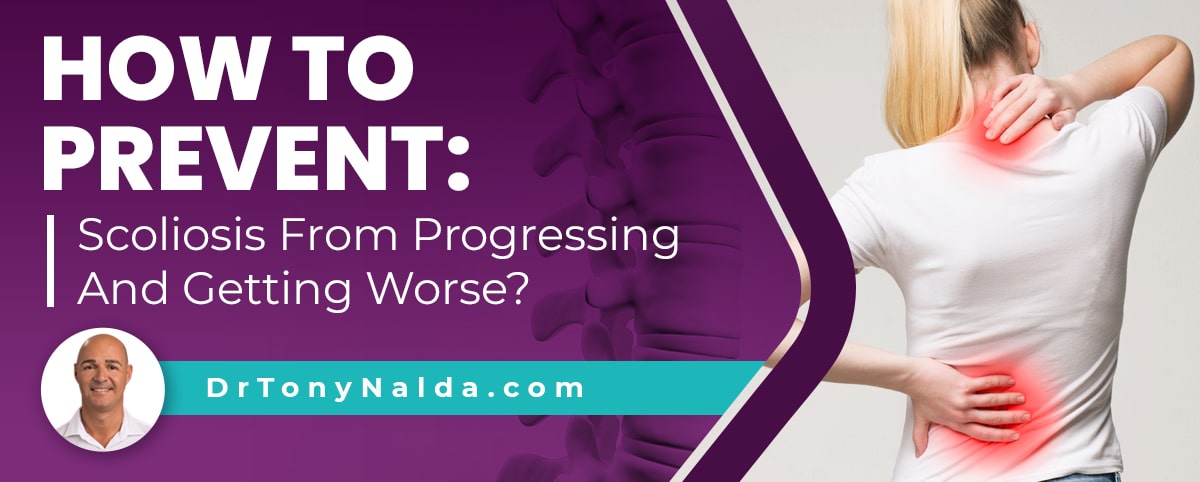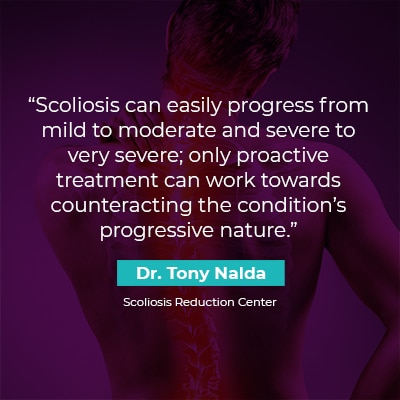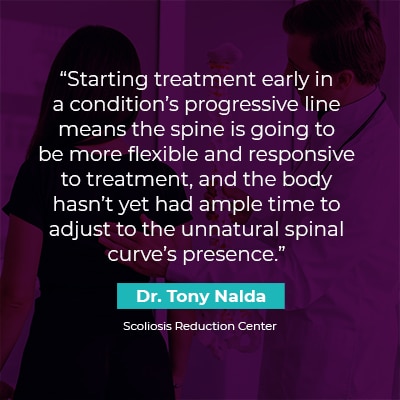How To Prevent Scoliosis From Progressing And Getting Worse?

When it comes to scoliosis treatment, patients, and their families, have to understand the importance of choosing the right treatment approach; different treatment approaches produce different results, so patients need to ensure that their treatment expectations are aligned with their potential outcomes. Scoliosis is progressive, but can be highly treatable.
How to prevent scoliosis from progressing is one of my favorite subjects because it increases awareness. As a progressive condition, scoliosis has it in its nature to worsen over time, and knowing the importance of a proactive treatment approach can set patients on the path of treatment success.
Let’s start with how a diagnosis of scoliosis is met, along with some key condition characteristics.
Table of Contents
How is Scoliosis Diagnosed?
With current estimates at close to seven million people currently living with scoliosis in the United States alone, it is a highly-prevalent spinal condition that people need to be aware of.
The reason I say “people need to be aware of,” is because it’s not always easy to diagnose scoliosis, which is why a large focus of my career and practice is educating and spreading awareness on the condition’s early signs to look for.
While there are never treatment guarantees, early detection and intervention has a number of treatment benefits.
Scoliosis involves the development of an unnatural sideways spinal curve that also rotates, making it a 3-dimensional structural spinal condition.
There has to be a rotational component to be diagnosed as a true scoliosis, and in addition, the unnatural spinal curve has to be of a minimum size: Cobb angle measurement of at least 10 degrees.
A key condition-characteristic is determined by a patient’s Cobb angle measurement and that is condition severity.
Condition Severity
Condition severity is a key condition-characteristic because treatment plans have to be customized around these types of variables.
Condition severity is determined by a patient’s Cobb angle: a measurement taken during X-ray by drawing lines from the tops and bottoms of the curve’s most-tilted vertebrae.
The intersecting lines form an angle that’s expressed in degrees, and this tells me how far out of alignment a scoliotic spine is.
When the spine’s natural and healthy curves are in place, its vertebrae (bones) are stacked on top of one another in a straight, natural, and neutral alignment, which is the spine’s natural design.
When one or more vertebrae shift out of alignment with the rest of the spine, its healthy curves are disrupted, and the spine’s natural and healthy curves make it stronger, more flexible, and better able to handle stress incurred during movement.
A patient’s Cobb angle also classifies conditions based on severity:
- Mild scoliosis: Cobb angle measurement of between 10 and 25 degrees
- Moderate scoliosis: Cobb angle measurement of between 25 and 40 degrees
- Severe scoliosis: Cobb angle measurement of 40+ degrees
- Very-severe scoliosis: Cobb angle measurement of 80+ degrees
The higher a Cobb angle, the more out of alignment the spine is, and the more severe the condition.
In addition, the condition’s severity levels are also its progressive line.
Scoliosis is Progressive
Scoliosis being a progressive condition means it has it in its very nature to worsen over time, so where a scoliosis is at the time of diagnosis isn’t indicative of where it will stay.
 Scoliosis can easily progress from mild to moderate and severe to very severe; only proactive treatment can work towards counteracting the condition’s progressive nature.
Scoliosis can easily progress from mild to moderate and severe to very severe; only proactive treatment can work towards counteracting the condition’s progressive nature.
So what I really want patients to understand is the importance of how a diagnosis is responded to.
There are two main scoliosis treatment approaches: traditional and conservative.
Traditional scoliosis treatment commonly responds to a diagnosis of mild scoliosis with a recommendation to simply watch and wait, meaning waiting for the condition to progress; this is a decision that can have far-reaching effects.
Watching and waiting for a progressive condition to progress, to me, is wasting valuable treatment time, and this is why: the milder scoliosis is, the simpler it is to treat.
Preventing Scoliosis From Getting Worse
Preventing scoliosis from getting worse isn’t always a simple process.
Not only does scoliosis range widely in severity, it also affects all ages and has different types that can develop, based on causation.
However, regardless of these different variables, the best time to start scoliosis treatment is always now, as is often the case with progressive conditions that are virtually guaranteed to get worse.
Scoliosis progressing means the size of the unnatural spinal curve is increasing, and this doesn’t just affect the spine, but also a person’s posture, and the spine’s surrounding muscles and nerves.
A scoliotic curve that’s progressing is making the spine more rigid and less responsive to treatment, and in a conservative treatment approach, physical therapy, condition-specific exercises (SSEs) and stretches are an important facet of treatment.
A spine that’s excessively rigid, due to progression, is less able to perform some of these key therapeutic exercises, hampering treatment efficacy; in these cases, preparatory work has to be done before starting the regular course of treatment in order to establish a baseline level of spinal flexibility.
In addition, the condition’s uneven forces not only cause postural deviation, but can also lead to a muscle imbalance around the spine.
The spine’s surrounding muscles are key to its ability to maintain its natural and healthy curves as they support and stabilize the spine; an unnaturally-curved spine pulls its surrounding muscles in different directions, often causing muscles on one side of the spine to become stretched and loose from overuse, while the muscles on the opposite side become weak from underuse.
The more a condition is left to progress, the more noticeable its effects are going to be, and it’s far simpler to proactively work towards preventing these increasing effects than trying to reverse them once they’ve developed, and this is where a proactive treatment approach comes in.
Proactive Conservative Treatment
Here at the Scoliosis Reduction Center, my patients benefit from a proactive and integrative conservative treatment approach.
Unlike traditional treatment, I want to start treatment as close to the time of diagnosis as possible because this increases the likelihood of treatment success.
 Starting treatment early in a condition’s progressive line means the spine is going to be more flexible and responsive to treatment, and the body hasn’t yet had ample time to adjust to the unnatural spinal curve’s presence.
Starting treatment early in a condition’s progressive line means the spine is going to be more flexible and responsive to treatment, and the body hasn’t yet had ample time to adjust to the unnatural spinal curve’s presence.
In addition, condition effects such as severe postural deviation and muscle imbalances are less likely.
An integrative treatment approach means that multiple different treatment disciplines are combined so conditions can be impacted on every level, and patients of the Center benefit from having access to many different types of treatment under one roof.
I combine condition-specific chiropractic care, physical therapy, corrective bracing, and rehabilitation.
Chiropractic Care
As a structural spinal condition, scoliosis has to be impacted, primarily, on a structural level, and this is worked towards through chiropractic care.
Chiropractic care involves a series of techniques and manual adjustments that, when successful, can reposition the curve’s most-tilted vertebrae back into alignment with the rest of the spine.
Physical Therapy
There was a time when the place of exercise in scoliosis treatment was questioned, but we’ve since learned that condition-specific exercise can be an important facet of corrective treatment.
Physical therapy involves custom-prescribed scoliosis-specific exercises and stretches that work towards strengthening the spine’s surrounding muscles so they can optimally support/stabilize the spine, addressing any related muscle imbalances, and postural remodeling.
Corrective Bracing
Corrective bracing can be particularly effective on growing spines, so is particularly beneficial as a facet of treatment for scoliosis in children.
The condition’s most-prevalent type is adolescent idiopathic scoliosis (AIS), diagnosed between the ages of 10 and 18, and while the idiopathic classification means we don’t fully understand what triggers its initial onset, we do know what triggers its progression: growth and development.
So being proactive with treatment is especially important for scoliosis in children because they are at risk for rapid-phase progression, particularly when the stage of puberty starts with rapid and unpredictable growth spurts.
An ultra-corrective brace, such as the ScoliBrace, can help augment corrective treatment results by pushing the spine into a corrective position.
Rehabilitation
Rehabilitating the spine is important for sustainable long-term treatment results, and this involves guidance on how to lead a scoliosis-friendly lifestyle, and a series of custom-prescribed exercises and stretches to further stabilize the spine.
These exercises are easily performed at home so patients can establish a home-rehabilitation routine.
Conclusion
As a progressive condition, scoliosis is virtually guaranteed to progress at some point, and while treatment results can never be guaranteed, responding to a diagnosis with proactive treatment has numerous benefits.
As traditional scoliosis treatment doesn't have a strategy for addressing scoliosis while mild, it commonly funnels patients towards spinal fusion surgery, but a proactive conservative treatment approach works towards corrective results that help patients avoid the potential risks, side effects, and complications of invasive spinal surgery.
The best way to prevent scoliosis from getting worse is reached through education, awareness, and a proactive treatment approach that works towards preserving as much of the spine’s natural strength and function as possible.
Dr. Tony Nalda
DOCTOR OF CHIROPRACTIC
After receiving an undergraduate degree in psychology and his Doctorate of Chiropractic from Life University, Dr. Nalda settled in Celebration, Florida and proceeded to build one of Central Florida’s most successful chiropractic clinics.
His experience with patients suffering from scoliosis, and the confusion and frustration they faced, led him to seek a specialty in scoliosis care. In 2006 he completed his Intensive Care Certification from CLEAR Institute, a leading scoliosis educational and certification center.
About Dr. Tony Nalda
 Ready to explore scoliosis treatment? Contact Us Now
Ready to explore scoliosis treatment? Contact Us Now





